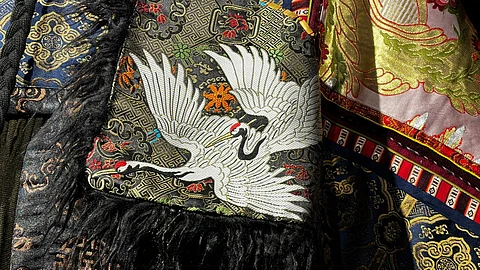
- HOMEGROWN WORLD
- #HGCREATORS
- #HGEXPLORE
- #HGVOICES
- #HGSHOP
- CAREERS
- ABOUT US
- CONTACT US

"There are 32 tribal communities in Jharkhand, each with their unique food, lifestyle, and fashion identities," says Ashish Satyavrat Sahu, the founder and designer of Johargram, a sustainable streetwear brand based in Jharkhand. "When I started working in the fashion industry, there was no awareness of Jharkhand's tribal textiles in the mainstream. People used to think we were from the northeast. I wanted to change that. So Johargram came up with the idea of creating streetwear using Jharkhand's tribal textiles. I want to see to it that each tribal community can be recognised by their unique textiles."
Historically, across Jharkhand — and the rest of India — ancient, indigenous textile traditions were born out of necessity. They were made by indigenous peoples and meant for the personal use of the weavers themselves and their immediate family, friends, relatives, and neighbours. But beyond that, these textiles were also living archives of the weavers' lives and histories — they were documents of a living heritage passed down through generations. From the colour of the yarns to the patterns of the weave, every single aspect of these textiles was imbued with rich histories and the heritage of the weaver's tribe, community, and family.
'Indigenous Fashion Futures: A Living Archive', a group exhibition curated by Sreyansi Singh, maps these histories of what the body wears — peoples’ memories, histories of forgotten gods, and myths of the land.
Bringing together four sustainable, conscientious community-focused fashion labels Boito, EAST, 2112 Saldon, and Johargram from across the country, the exhibition is a first-of-its-kind mapping of indigenous fashion identities through contemporary design and future possibilities. The show will spotlight designers who belong to the communities and work with these communities to create a new design iconography — clothes-led, object-driven, political, anthropological, and business-forward.
As you enter the exhibition, the first exhibit you see is a fashion installation (as seen above) by Boito — a conscientious luxury label devoted to preserving and reimagining Odisha's rich textile heritage. The installation draws from the state's indigenous textile traditions such as kotpad, kapdaganda, and sambalpuri pasapalli (which features motifs of the ancient 'passa' board-game), as well as craft traditions like dhokra.
At the other end of the exhibition — both literally and figuratively — Ladakh-based label 2112 Saldon's display, designed by Padma Saldon, founder and creative head of the label, breaks down the different elements of traditional Ladakhi attires such as the 'bok', a traditional Ladakhi cloak, to create contemporary silhouettes. 2112 Saldon works closely with indigenous herding and weaving communities of the high-altitude region to create these contemporary designs from traditional hand-spun and hand-woven Nambu sheep's wool textiles.
Drawing from a diverse range of these indigenous textiles traditions from Odisha, Jharkhand, Manipur, and Ladakh, the exhibition takes a transformative approach to creating a new genre of fashion installations that are not just clothes-first and abashedly contemporary, but also informed by history, community, as well as textile, and craft traditions.
'Indigenous Fashion Futures: A Living Archive', a group exhibition curated by Sreyansi Singh, opens on February 3 and is on view till February 9, 2025, as part of India Art Fair 2025, at Triveni Kala Sangamm, 205 Tansen Marg, Mandi House, New Delhi.
If you enjoyed reading this, here's more from Homegrown:
Take A Journey Into Odia Culture With Label Boito's Handcrafted Textiles
Homegrown Streetwear Brand Johargram Explores Jharkhandi Textile & Local Artisan Identity
Indian Label Saldon Celebrates The Artisanal Legacy Of Leh Through Handcrafted Clothing
